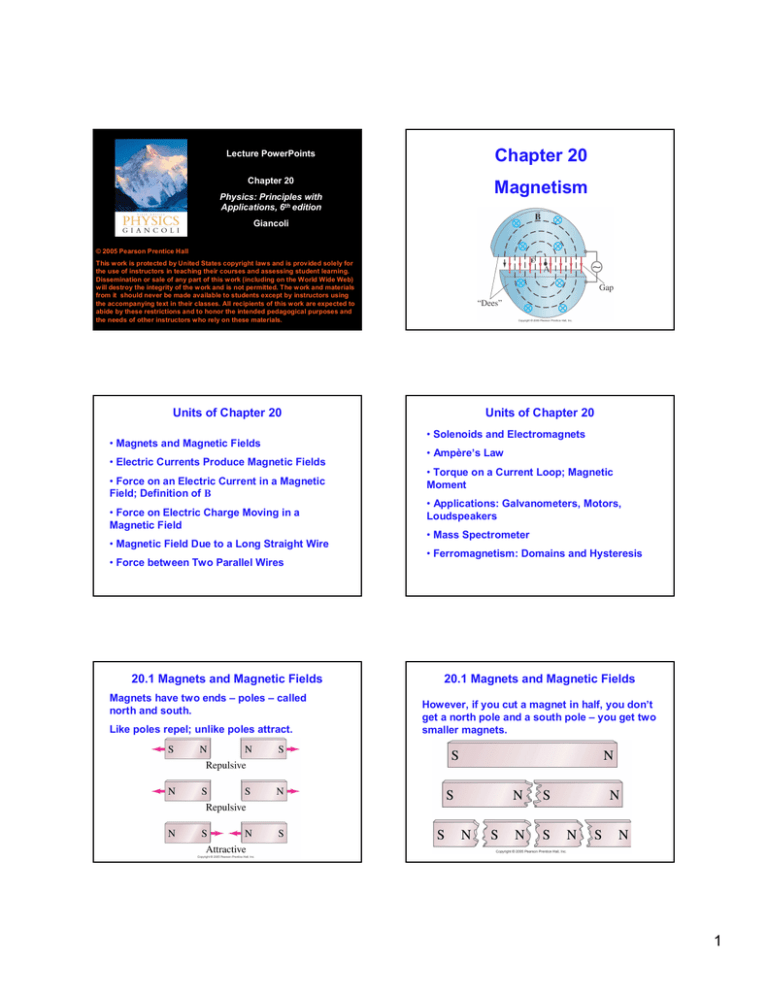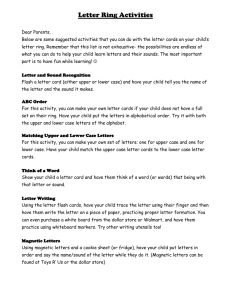
Lecture PowerPoints
Chapter 20
Chapter 20
Magnetism
Physics: Principles with
Applications, 6th edition
Giancoli
© 2005 Pearson Prentice Hall
This work is protected by United States copyright laws and is provided solely for
the use of instructors in teaching their courses and assessing student learning.
Dissemination or sale of any part of this work (including on the World Wide Web)
will destroy the integrity of the work and is not permitted. The work and materials
from it should never be made available to students except by instructors using
the accompanying text in their classes. All recipients of this work are expected to
abide by these restrictions and to honor the intended pedagogical purposes and
the needs of other instructors who rely on these materials.
Units of Chapter 20
• Magnets and Magnetic Fields
• Electric Currents Produce Magnetic Fields
• Force on an Electric Current in a Magnetic
Field; Definition of B
• Force on Electric Charge Moving in a
Magnetic Field
• Magnetic Field Due to a Long Straight Wire
• Force between Two Parallel Wires
20.1 Magnets and Magnetic Fields
Magnets have two ends – poles – called
north and south.
Like poles repel; unlike poles attract.
Units of Chapter 20
• Solenoids and Electromagnets
• Ampère’s Law
• Torque on a Current Loop; Magnetic
Moment
• Applications: Galvanometers, Motors,
Loudspeakers
• Mass Spectrometer
• Ferromagnetism: Domains and Hysteresis
20.1 Magnets and Magnetic Fields
However, if you cut a magnet in half, you don’t
get a north pole and a south pole – you get two
smaller magnets.
1
20.1 Magnets and Magnetic Fields
Magnetic fields can be visualized using
magnetic field lines, which are always closed
loops.
20.1 Magnets and Magnetic Fields
The Earth’s magnetic field is similar to that of a
bar magnet.
Note that the Earth’s
“North Pole” is really
a south magnetic
pole, as the north
ends of magnets are
attracted to it.
20.1 Magnets and Magnetic Fields
A uniform magnetic field is constant in
magnitude and direction.
20.2 Electric Currents Produce Magnetic
Fields
Experiment shows that an electric current
produces a magnetic field.
The field between
these two wide poles
is nearly uniform.
20.2 Electric Currents Produce Magnetic
Fields
The direction of the
field is given by a
right-hand rule.
20.3 Force on an Electric Current in a
Magnetic Field; Definition of B
A magnet exerts a force on a currentcarrying wire. The direction of the force is
given by a right-hand rule.
2
20.3 Force on an Electric Current in a
Magnetic Field; Definition of B
The force on the wire depends on the
current, the length of the wire, the magnetic
field, and its orientation.
20.3 Force on an Electric Current in a
Magnetic Field; Definition of B
Unit of B: the tesla, T.
1 T = 1 N/A·m.
Another unit sometimes used: the gauss (G).
(20-1)
1 G = 10-4 T.
This equation defines the magnetic field B.
The terrestrial magnetic field is about 1 G.
Force on 1m wire carrying 1 A current: F = 10-4 N
20.4 Force on Electric Charge Moving in a
Magnetic Field
The force on a moving charge is related to
the force on a current:
(20-3)
Once again, the
direction is given by
a right-hand rule.
20.4 Force on Electric Charge Moving in a
Magnetic Field
20.4 Force on Electric Charge Moving in a
Magnetic Field
If a charged particle is
moving perpendicular
to a uniform magnetic
field, its path will be a
circle.
20.4 Force on Electric Charge Moving in a
Magnetic Field
General case: helical trajectory
Aurora borealis
(northern lights)
are caused by
charged particles
streaming from
the sun.
3
20.4 Force on Electric Charge Moving in a
Magnetic Field
20.4 Force on Electric Charge Moving in a
Magnetic Field
Problem solving: Magnetic fields – things to
remember
1. The magnetic force is perpendicular to the
magnetic field direction.
2. The right-hand rule is useful for determining
directions.
3. Equations in this chapter give magnitudes
only. The right-hand rule gives the direction.
20.8 Ampère’s Law
Ampère’s law relates the
magnetic field around a
closed loop to the total
current flowing through
the loop.
20.8 Ampère’s Law
Ampère’s law can be used to calculate the
magnetic field in situations with a high degree
of symmetry.
(20-9)
Circular field:
2π r B = µ 0 I
20.5 Magnetic Field Due to a Long Straight
Wire
The field is inversely proportional to the
distance from the wire:
20.6 Force between Two Parallel Wires
The magnetic field produced
at the position of wire 2 due to
the current in wire 1 is:
(20-6)
The constant 0 is called the permeability of
free space, and has the value:
The force this field exerts on
a length l2 of wire 2 is:
(20-7)
4
20.6 Force between Two Parallel Wires
Parallel currents attract; antiparallel currents
repel.
20.12 Ferromagnetism: Domains and
Hysteresis
Ferromagnetic materials are those that
can become strongly magnetized, such as
iron and nickel.
These materials are made up of tiny
regions called domains; the magnetic field
in each domain is in a single direction.
20.12 Ferromagnetism: Domains and
Hysteresis
20.12 Ferromagnetism: Domains and
Hysteresis
Starting with unmagnetized
material and no magnetic
field, the magnetic field can
be increased, decreased,
reversed, and the cycle
repeated. The resulting plot
of the total magnetic field
within the ferromagnet is
called a hysteresis curve.
When the material is
unmagnetized, the
domains are randomly
oriented. They can be
partially or fully aligned by
placing the material in an
external magnetic field.
20.7 Solenoids and Electromagnets
20.7 Solenoids and Electromagnets
A solenoid is a long coil of wire. If it is tightly
wrapped, the magnetic field in its interior is
almost uniform:
bc and da sections cancel, only cd is relevant.
Total current depends on number of loops, N
(20-8)
5
20.7 Solenoids and Electromagnets
If a piece of iron is inserted in the solenoid, the
magnetic field greatly increases. Such
electromagnets have many practical
applications.
20.9 Torque on a Current Loop; Magnetic
Moment
20.9 Torque on a Current Loop; Magnetic
Moment
20.10 Applications: Galvanometers,
Motors, Loudspeakers
For N loops of wire each carrying the current I,
the magnitude of the torque is given by:
Force on each side:
F = NI a B sinθ
(20-10)
A galvanometer
takes advantage of
the torque on a
current loop to
measure current.
The quantity NIA is called the magnetic
dipole moment, M:
(20-11)
20.10 Applications: Galvanometers,
Motors, Loudspeakers
An electric motor
also takes
advantage of the
torque on a current
loop, to change
electrical energy to
mechanical energy.
20.10 Applications: Galvanometers,
Motors, Loudspeakers
Loudspeakers use the
principle that a magnet
exerts a force on a
current-carrying wire to
convert electrical
signals into mechanical
vibrations, producing
sound.
6
20.11 Mass Spectrometer
A mass spectrometer measures the masses of
atoms. If a charged particle is moving through
perpendicular electric and magnetic fields,
there is a particular speed at which it will not
be deflected:
F = qE + qvB = 0
20.11 Mass Spectrometer
All the atoms
reaching the second
magnetic field will
have the same
speed; their radius of
curvature will depend
on their mass and
charge.
We measure q/m.
Summary of Chapter 20
• Magnets have north and south poles
• Like poles repel, unlike attract
• Unit of magnetic field: tesla
• Electric currents produce magnetic fields
Summary of Chapter 20
• A magnetic field exerts a force on a moving
charge:
• Magnitude of the field of a long, straight
current-carrying wire:
• A magnetic field exerts a force on an electric
current:
• Parallel currents attract; antiparallel
currents repel
Summary of Chapter 20
• Magnetic field inside a solenoid:
• Ampère’s law:
• Torque on a current loop:
7






